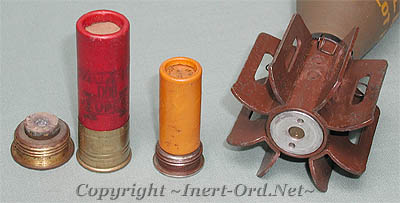
Shown are the 60mm M49A2 HE round and the M69 solid cast iron training version. These were used in the M2 Mortar.
They weighed 3 pounds and had a maximum range of 2,000 yards, although accuracy was diminished at ranges over 1,000.
While having less power than the 81mm mortar, the 60mm was easy to transport and could be brought into action quickly, which was its prime asset.
The 60mm M2 was a versatile and reliable performer. A key infantry weapon during World War II.

Next is the 81mm M43A1 HE Round. It is the smallest of the high explosive shells made for the M1 81mm Mortar. It weighed 6.9 pounds
and had a maximum range of 3,290 yards.
The heaviest of the 81mm types was the M56, weighing 15 lbs, with a maximum range of 1,300yards. There was also 10.6 pound type, designated M45.
White Phosphorus and Illumination rounds were also made for each caliber.



